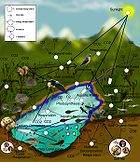- Animal coloration
-
 Chapman's Zebras in Botswana, displaying their outline-disrupting camouflage
Chapman's Zebras in Botswana, displaying their outline-disrupting camouflage
Animal coloration has been a topic of interest and research in biology for well over a century. According to Charles Darwin's 1859 theory of natural selection,[1] features such as coloration evolved by providing individual animals with a reproductive advantage. For example, an individual with slightly better camouflage than others of the same species would on average leave more offspring.
There are at least six separate reasons why animal coloration may evolve:
- Camouflage, enabling an animal to remain hidden from view
- Warning, signalling to other animals not to attack
- Mimicry, taking advantage of another species' warning coloration
- Sexual selection, signalling to other members of the same species
- Simple physical protection, such as having pigments to protect against sunburn
- and purely incidental coloration, such as having red blood because, as it happens, haem (needed to carry oxygen) is red.
These reasons are briefly introduced below: they are covered in detail in separate articles.
Contents
Camouflage
Main article: CamouflageOne of the pioneers of research into animal coloration, Edward Bagnall Poulton[2] classified the forms of protective coloration including camouflage in a way which is still helpful[3]:
- Protective resemblance
- Special: the whole animal looks like some other object, for example when a caterpillar resembles a twig or a bird dropping. This is now called Mimesis
- General: the animal's texture blends with the background, for example when a moth's colour and pattern blend in with tree bark. This is now called crypsis
- Aggressive resemblance
- Special: a predator (or parasite) looks like something else, luring the prey to approach, for example when a flower mantis resembles a particular kind of flower, such as an orchid
- General: a predator or parasite blends in with the background, for example when a leopard is hard to see in long grass
- Adventitious protection: an animal uses materials such as twigs, sand, or pieces of shell to conceal its outline, for example when a Caddis Fly larva builds a decorated case, or when a crab decorates its back with seaweed, sponges and stones
- Variable protective resemblance: an animal such as a chameleon, flatfish, squid or octopus changes its skin pattern and colour using special chromatophore cells to resemble whatever background it is currently resting on (as well as for signalling). See also Category:Animals that can change color.
The Theory of camouflage seeks to explain how resemblances such as those noted by Poulton are achieved. The main mechanisms, which apply equally in nature and in military applications are:
- Cryptic, blending into the background so as to become hard to see (this covers both special and general resemblance)
- Disruptive, using colour and pattern to break up the animal's outline (this relates mainly to general resemblance)
- Mimicry (in a narrow sense: other types of mimicry are described separately), resembling other objects of no special interest to the observer (this relates to special resemblance)
- Countershading, using graded colour to create the illusion of flatness (this relates mainly to general resemblance).
Countershading was first described by the American artist Abbott Handerson Thayer, a pioneer in the theory of animal coloration. Thayer observed that whereas a painter takes a flat canvas and uses coloured paint to create the illusion of solidity by painting in shadows, animals such as deer are often darkest on their backs, becoming lighter towards the belly, creating (as zoologist Hugh Cott observed) the illusion of flatness[4], and against a matching background, of invisibility. Thayer's observation "Animals are painted by Nature, darkest on those parts which tend to be most lighted by the sky's light, and vice versa" is called Thayer's Law.[5]
Warning coloration
Main article: AposematismFurther information: signalling theoryWarning coloration (aposematism) is effectively the "opposite" of camouflage. Its function is to make the animal, for example a wasp or a coral snake, highly conspicuous to potential predators, so that it is noticed, remembered, and then avoided. As Peter Forbes observes, "Human warning signs employ the same colours - red, yellow, black, and white - that nature uses to advertise dangerous creatures."[6] Warning colours work by being associated by potential predators with something that makes the warning-coloured animal unpleasant or dangerous. This can be achieved in several ways:
- distasteful, for example a Cinnabar moth caterpillar has bitter-tasting chemicals in its blood
- foul-smelling, for example the skunk can eject a liquid with a long-lasting and powerful odour
- poisonous, for example a wasp can deliver a painful sting, while a viper can deliver a fatal bite
Warning coloration can succeed either through inborn ("instinctual") behaviour on the part of potential predators, or through a learned avoidance. Either can lead to various forms of mimicry.
Mimicry
Main article: MimicryThe existence of warning coloration (aposematism) makes it possible for mimicry to evolve, because it enables natural selection to drive slight, chance, resemblance to progressively more perfect mimicry. There are numerous possible mechanisms, of which by far the best known are:
- Batesian mimicry, the resemblance of edible to distasteful animals, most commonly insects such as butterflies; a familiar example is the resemblance of harmless hoverflies (which have no sting) to bees
- Müllerian mimicry, the mutual resemblances among distasteful animals, most commonly insects such as wasps and bees (hymenoptera)
Batesian mimicry was first described by pioneering naturalist Henry W. Bates. When an edible prey animal comes to resemble, even slightly, a distasteful animal (not necessarily closely related to it), natural selection favours those individuals that even very slightly better resemble the distasteful target. This is because even a small degree of protection reduces predation and increases the chance that an individual mimic will survive and reproduce. For example, many species of hoverfly are coloured black and yellow like bees, and are in consequence avoided by birds (and people).[7]
Müllerian mimicry was first described by pioneering naturalist Fritz Müller. When a distasteful animal comes to resemble a more common distasteful animal, natural selection favours individuals that even very slightly better resemble the target. For example, many species of stinging wasp and bee are similarly coloured black and yellow. Müller's explanation of the mechanism for this was one of the first uses of mathematics in biology.[8]
Müller's argument runs basically (using a simple example rather than equations) as follows:
- Suppose there are, say, 100 wasps of rare species A and 1000 wasps of common species B in a place.
- Suppose that wasps are eaten by young inexperienced birds, which quickly learn after one trial, by getting stung in the mouth, not to eat wasps again.
- Suppose there are 10 young birds in the place.
- If species A does not resemble B (to the birds), then each young bird must eat one A and one B to learn to avoid them. 10 out of 100 wasps of species A, and 10 out of 1000 wasps of species B perish in the training process. Note that in this example, A is 10 times rarer than B, and therefore suffers 10 times as heavily.
- Now suppose that species A resembles B perfectly, so the young birds cannot distinguish them. Each young bird now needs only to eat one wasp - A or B, it doesn't matter - to learn to avoid both of them.
- The advantage gained by species A of resembling species B is that where before 10 individuals of species A perished, now only about 1 perishes, as most of the wasps sampled by the young birds at random will belong to the commoner species B. Note that there is a large gain from the resemblance in the rare species, and a small gain (1 fewer individual out of 1000 perishes) in the common species: in fact, A's gain is 100 times as much as B's, comparing before and after.
- Therefore there is a powerful selective pressure favouring progressively closer resemblance of species A to species B.
 Four insects of different families, all warning coloured in bold red and black in varying patterns, illustrating Müllerian mimicry. From left: a Soldier Beetle Trichodes alvearius; a Homopteran froghopper bug Cercopsis vulnerata; a firebug Pyrrhocoris apterus; an Italian Striped-bug Graphosoma italicum
Four insects of different families, all warning coloured in bold red and black in varying patterns, illustrating Müllerian mimicry. From left: a Soldier Beetle Trichodes alvearius; a Homopteran froghopper bug Cercopsis vulnerata; a firebug Pyrrhocoris apterus; an Italian Striped-bug Graphosoma italicum
Sexual selection
 Male and female Goldie's Bird of Paradise display marked sexual differences (dimorphism) created by sexual selection.
Male and female Goldie's Bird of Paradise display marked sexual differences (dimorphism) created by sexual selection. Main article: sexual selection
Main article: sexual selectionDarwin observed that the males of some species, such as Birds of Paradise (see illustration), were very different from the females.
Darwin suggested an explanation of these differences in his theory of sexual selection (The Descent of Man, London, 1874): once the females begin to select males according to any particular characteristic, such as a long tail or a coloured crest, that characteristic will progressively be emphasized in the males. Eventually all the males will have the characteristics that the females are sexually selecting for strongly emphasized, as any male that does not will not reproduce. Note that this mechanism is so powerful that it is able to create features that are strongly disadvantageous to the males in other ways: for example, some male Birds of Paradise have wing or tail streamers that are so long that they may impede flight, while their brilliant colours may make the males more vulnerable to predators. In the extreme, it may be that sexual selection has driven species to extinction, as has been argued for the enormous horns of the male Irish Elk.[9]
Different forms of sexual selection are possible, including rivalry among males, and selection of females by males.
Physical protection
Further information: Biological pigmentMany animals have dark pigments such as melanin in their skin, eyes and fur to protect themselves against sunburn (damage to living tissues caused by ultraviolet light).
Incidental coloration
Further information: Biological pigmentSome animals are coloured purely incidentally because substances that they produce for other purposes happen to be pigments. For example, amphibians that live in caves may be largely colourless as colour has no function in that environment, but they may have red blood and show some red in their skin because the haem in their blood cells, needed to carry oxygen, happens to be red.
References
Further reading
Pioneering books
- Bates, H. W. (1857) The Naturalist on the River Amazons (2 volumes). John Murray, London.
- Cott, H. B. (1940) Adaptive Coloration in Animals. Methuen, London.
- Darwin, C. (1874) The Descent of Man. London.
- Darwin, C. (1859) On the Origin of Species. London. Reprinted 1985, Penguin Classics, Harmondsworth.
- Poulton, E. B. (1890) The colours of Animals. London.
- Thayer, A. H. and G. H. Thayer (1909) Concealing Colouration in the Animal Kingdom. New York.
- Wallace, A. R. (1895) Natural Selection and Tropical Nature. London.
General reading
- Forbes, P. (2009) Dazzled and Deceived: Mimicry and Camouflage. Yale, New Haven and London.
- Wickler, W. (1968) Mimicry in plants and animals. McGraw-Hill, New York.
Children's books
- Kalman, B. and J. Crossingham. What are Camouflage and Mimicry?. Crabtree Publishing. (ages 4-8)
- Maze, S. (2006) Beautiful Moments in the Wild: Animals and Their Colors. Moonstone Press, LLC. (ages 4–8)
- Mettler, R. (2001) Animal Camouflage. Moonlight Publishing.
External links
- NatureWorks: Coloration (for children and teachers)
- HowStuffWorks: How Animal Camouflage Works
- Sexual Selection (a lecture for Zoology students)

Eyes Evolution Colouration - Animal colouration
- Aposematism
- Camouflage
- Chromatophore
- Countershading
- Crypsis
- Eyespot (mimicry)
- Theory of camouflage
- Underwater camouflage and mimicry
Related topics Categories:- Zoology
- Biology
- Biological evolution
- Human evolution
- Color
- Animals
Wikimedia Foundation. 2010.






